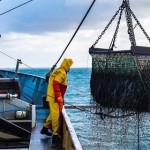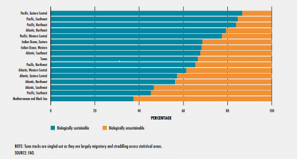Overcoming their differences, both developed and developing countries agreed at the World Trade Organization’s ministerial meeting on June 17th to eliminate subsidies that cause overfishing. The hectic negotiations that continued beyond the deadline, delivered a package of deals- including the one on fisheries subsidies- ending a drought of almost a decade of global trade accords.
The agreement on fisheries creates a global framework curbing subsidies for illegal, unreported and unregulated (IUU) fishing. Hailed as historic, the accord is step towards meeting sustainable development goals (SDGs), the first multilateral agreement to do so.
The United Nations Food and Agricultural Organization (FAO) estimates that two-thirds of global fish stocks are being overfished beyond replenishment levels[1] and an estimated $20 billon of $35 billion annual subsidies are partly responsible as they lead to aggressive fishing inside as well as outside countries’ Exclusive Economic Zones (EEZ). Large and advanced countries like China, the U.S., Japan, South Korea subsidize the most– $5-$8 billion annually. In comparison, other developing countries like India, subsidize their fisheries sector only fractionally- few hundred million dollars or less.
| No. | Type of subsidy/ support for fisheries | Details |
| 1. | Enabling subsidies | Support to purchase of vessels, fishing gear, upgrading fishing fleet, subsidies for other capital costs |
| 2. | Tax exemptions and other support to the sector | Fuel tax exemptions, subsidies for fuel purchase for fishing fleets, other tax exemptions for fish landings |
| 3. | Subsidies of individual benefits | Subsidies for insurance of fishing staff, human resource cost support etc. |
Fishing in most of the developing countries is done for subsistence unlike in the developed world where fishing at an industrial scale using advanced equipment is common. Therefore, although the WTO’s elimination of subsidies is a significant step in the right direction, developing countries were demanding longer time window to eliminate subsidies. Developed countries wanted the subsidies to be eliminated before 2030 to meet the SDG deadline and because subsidies of countries like China contribute heavily to overfishing. Developed countries seem to have prevailed by allowing a concession of two years for Least Developed Countries to phase out such subsidies.
Fisheries is an important source of livelihood of fishing communities. Globally, 59 million people are engaged in fisheries and aquaculture, 80% of them from Asia[2] and mostly marginalised, but are subsidised the least. Around 67 million tonnes of fish worth $164 billion are exported internationally every year.
Although the agreement is significant, it has serious shortcomings. First, the lack of a definition of unregulated and illegal fishing may create problems during the arbitration of violations. Instead of defining such illegal, unreported and unregulated fishing, the agreement refers to FAO’s plan to tackle the problem, one that relies on national regulations of member countries, or on regional fishing management organizations’ definitions. This can lead to confusion as to where fishing is permitted, especially in areas beyond EEZs.
Second is the agreement’s silence on overcapacity—allowing fishermen to catch more fish than is sustainable. Additional subsidies given for upgrading fishing vessels, gear, and manpower are contributing factors. The WTO meeting of 2017 tasked its successor in 2022, with developing comprehensive measures that prohibit overcapacity and overfishing. Accordingly, a working draft of the agreement submitted for this year’s negotiations did exactly that, but the WTO agreement dropped the suggestion completely, effectively allowing such subsidies that encourage overcapacity, to continue
Figure 1. World’s overfished regions (Source: FAO SOFIA 2020)
Third, the agreement relies on member states and regional fisheries bodies to identify overfished species and take measures to sustain them. This task could have been delegated to agencies like the FAO[3], the Pew Centre, and University of California[4] etc. which have rigorous mechanisms to collect big data using remote sensing technologies for reliable information which in turn support decision making. This can provide much needed transparency and credibility to the data but is not used.
Lastly, the agreement doesn’t specifically guarantee meaningful special and differential treatment to developing and least developed countries. It merely urges developed countries to provide voluntary technical and financial assistance to meet the objectives of the agreement. The Paris agreement exemplifies how difficult financial mobilization for climate change is from the developed world. Developing countries can only hope that the WTO agreement won’t be as ineffective.
Fishing on the high seas, beyond EEZs is mostly unviable for offending countries without government subsidies[5] which are often higher than profit margins. With the ban on subsidies kicking in, the price of highly sought-after fish species like shark, tuna and squid could skyrocket and instead accelerate overfishing.
Developing countries must formulate their own regulations and set up mechanisms to prevent illegal and unregulated overfishing within their territorial waters. To safeguard the livelihood of high seas fishing communities, multilateral platforms like SAARC, BIMSTEC, ASEAN, and QUAD need a shared understanding of terms ambiguously defined in the WTO agreement. These platforms can develop their own data bases and create mechanisms to identify and report habitual offenders like China which harm the environment and livelihoods of vulnerable fishing communities. It is these groups and their collective actions which will ensure that the WTO subsidy limits achieve their goal of conserving fish stock.
Damodar Pujari is Fellow, Climate Change Studies Programme, Gateway House.
This article was exclusively written for Gateway House: Indian Council on Global Relations. You can read more exclusive content here.
For permission to republish, please contact outreach@gatewayhouse.in
© Copyright 2022 Gateway House: Indian Council on Global Relations. All rights reserved. Any unauthorised copying or reproduction is strictly prohibited.
References:
[1] https://www.fao.org/documents/card/en/c/ca9229en
[2] https://www.fao.org/3/ca9229en/ca9229en.pdf
[3] https://www.fao.org/publications/sofia/2020/en/



